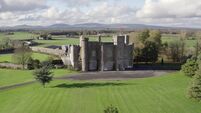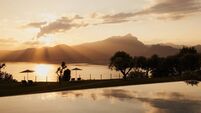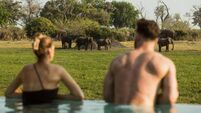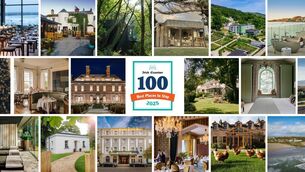By the lakes of Killarney

IS KILLARNEY Ireland’s biggest tourist magnet? Outside of the major cities we’d guess that it is.
Certainly, it ticks many boxes on the tourist trail: it has natural heritage, it has world- renowned history, it has the lakes, and it has its location on the Ring of Kerry.
Oh, and it has actor Michael Fassbender as one of its most famous sons.
Let’s look at its history first. Religious settlements played an important part in its development, and one of its earliest significant ones was the monastery (on nearby Innisfallen Island) that was founded in 640 by St Finian the Leper.
The monastery was a viable concern for over 850 years before Elizabeth I confiscated it in the late 1500s. Not that this stopped St Finian the Leper.
Not a man to throw his hand in at the first sign of upheaval, legend has it that he founded another monastery in nearby Aghadoe in the 6th (or 7th) century. As the centuries passed, so the usual level of invasions and rebellions continued — these included the Anglo-Norman invasion of Ireland in 1169, the Desmond Rebellions of the 1580s, and the Cromwellian tumult in the 1650s (during which Muckross Abbey, founded in 1448 by the Observantine Franciscans, was burned down).
Yet as far back as the mid-18th century, Killarney was attracting tourists (although the visitors probably weren’t termed that).
In the 250-year celebrations of the town, the date of 1747 was used to honour the history of its tourism appeal.
Come 1861, in which year Queen Victoria paid a visit, the town was becoming known internationally.
This was partly due to the railway infrastructure in Ireland, which arrived at the town in the summer of 1853. Within a year, the number of hotels in Killarney had more than doubled — from three to seven.
By 1860, tours of the Ring of Kerry had already turned into a thriving industry, and its start/finish point was Killarney.
Victorian writers extolled the journey of the 100-plus mile trip, with one man, Isaac Slater (a trade directory publisher), recommending Killarney as the base of operations: “It is a common and wise custom of those who make this tour, and are not pressed for time, to hire the carriage at the hotel in Killarney and continue with it all the way round. It is absolutely marvellous what these mountain-bred horses can get through, thinking nothing of even 50 miles in a single day.”
So much has changed since those pioneering days, but what has stayed on track has been Killarney’s profile as a place to visit.
There’s no denying that tourism is by far the largest industry here; anyone driving in from either side of the town can see the B&B and guesthouse signs leading into it, and as soon as you get to the centre you instantly know that this place is as much a hive of activity as it is a Mecca for visitor fun and games.
With a tourist population that is becoming increasingly diverse (America, Germany, UK and Asia are the most popular, but, to be honest, people come from everywhere to experience Killarney), it’s no shock whatsoever to discover that outside Dublin there are more hotel and B&B/ guesthouse beds here than in any other Irish town or city.
Perhaps a downside for the indigenous tourist is that so many of the shops are geared for non-Irish visitors, but this aside, the cliché of there being a welcome by the fireside for everyone holds some truth.
What is also true — and not at all contrived in the way that some gift shops might be — is the amount of splendid natural attractions right on the town’s doorstep.
We’ve already briefly mentioned the Ring of Kerry, and how Killarney is its obvious chosen base, but there’s no way we can ignore the likes of Ross Castle, Muckross House, and Killarney National Park. Each of these hold sway with tourist and native alike. Ross Castle is a 15th-century tower house/keep on the edge of Lough Leane, and is overseen by the OPW, which operates seasonal guided tours of the property.
Muckross House is situated on the tiny Muckross Peninsula between Muckross Lake and Lough Leane; in 1932, its then owners, Irish politician/barrister, Arthur Rose Vincent, and his parents-in-law, passed over its 11,000 acres estate to the Irish nation (essentially as a memorial to Vincent’s wife, Maud Bourn, who died of pneumonia in 1929).
The estate became the country’s first National Park and formed the substantial basis of the present day Killarney National Park.
Which brings us to exactly that: from the 30s onwards the park has been significantly expanded, and now covers almost 25,000 acres. Such an expanse is a tourist attraction in itself, and we have personally seen people stop in their tracks at the immense, often profound, beauty of it.
Between its mountain peaks, its lakes, its internationally important woodlands, its herd of red deer (the only native herd in Ireland), and its designation in 1981 as a Unesco Biosphere Reserve, there is little here that can’t recommend itself so hugely. The park is also one of the very few areas of land in the country that has been continuously covered by woodland since the end of the most recent (that’d be 10,000 years ago) glacial period. But enough of the chilly glacial period — what about now? You’ll be glad to know that the park is open all year round, but that’s ok — so is Killarney.
There are plenty of options here for all tastes and budget points. If you’re planning to splash out, then we’d recommend the Lake Room at Aghadoe Heights Hotel and Spa (aghadoeheights.com). Contemporary dining delivered in a sophisticated manner.
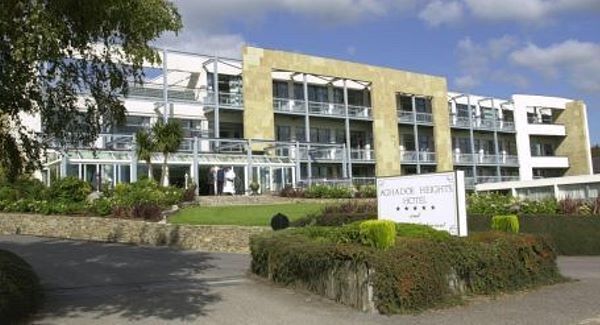
For a more down-to-earth but no less enjoyable experience in the town, book Robertino’s, 9 High St (robertinosrestaurant.com), a family restaurant in operation since 1993.
We’ve already mentioned Aghadoe Heights Hotel and Spa, but we’re sticking with it for our ‘sleep’ recommendations because it’s such a terrific place.
Located just outside Killarney, and right on the lakes, the hotel is the epitome of class and style.
If you want a hotel in the town, then try the Malton Hotel (themalton.com), a lovely Victorian property that harks back to a time (mid-1850s) when Killarney was merely an idea as a tourist destination.
Killarney’s Autumn Racing Festival runs from August 19 to 22, and features almost 30 races. The first three days feature evening meetings, and there is a sizeable prize fund of over €400,000 that is certain to attract interest from Ireland and UK’s premier stables.
The final day (Saturday) will see the festival host its very popular Ladies Day.
If racing doesn’t appeal, then perhaps heritage will? National Heritage Week runs from August 22 to 30, and takes place in the elegant surroundings of Muckross House and Gardens. Now that’s what you call a good match. Visit killarney.ie for more.







